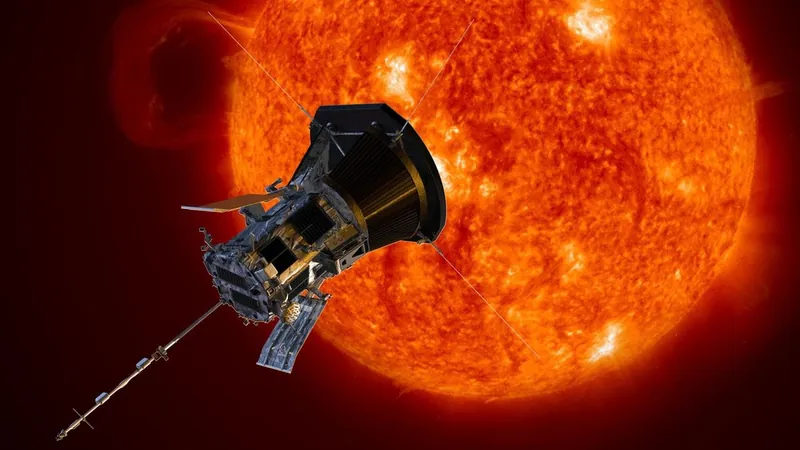
NASA's Parker Solar Probe Makes History with Near-Sun Encounter – What Did We Learn?
2025-01-02
Author: Emily
NASA's Parker Solar Probe Makes History
On January 1st, NASA's Parker Solar Probe returned with thrilling news just in time to kick off the new year. Following its groundbreaking approach to the sun, which saw it fly closer than any man-made object in history, the spacecraft began transmitting its first set of telemetry data back to mission control at Johns Hopkins University's Applied Physics Laboratory (JHUAPL) in Maryland.
The telemetry confirms that all systems aboard the Parker Solar Probe are functioning optimally. Michael Buckley, a spokesperson from JHUAPL, remarked, "All is looking good with the spacecraft systems and instrument operations. It really is a remarkable spacecraft!" The probe successfully executed commands from its onboard flight computers, ensuring that its scientific instruments were operational during this significant flyby.
Record-Breaking Encounter
During this record-breaking encounter, the Parker Solar Probe approached within 3.8 million miles (6.1 million kilometers) of the sun's surface, collecting unprecedented data that will shed light on our star. Helene Winters, the program manager for the mission, stated, "While Parker Solar Probe was closer to the sun than any other human-made object in history, it operated just as it was designed to do, and made observations that no one has been able to make before."
As mission control continues to receive telemetry data via NASA's Deep Space Network, the probe is anticipated to send back its collected scientific data later in January, utilizing its powerful antenna for a more robust transmission with Earth. "The data that will come down from the spacecraft will be fresh information about a place that we, as humanity, have never been," said Joe Westlake from NASA Headquarters. "It's an amazing accomplishment."
Unmatched Speed and Heat Resilience
The Parker Solar Probe achieved a staggering speed of 430,000 miles per hour (690,000 kilometers per hour) during its journey through the sun's scorching atmosphere, easily surpassing its previous speed records. In a breathtaking comparison, this speed is enough to fly from Tokyo to Washington, D.C. in just a minute!
Throughout this daring mission phase, scientists temporarily lost contact with the probe, holding their breath until they received a signal just before midnight on December 26 indicating that the spacecraft emerged from its solar encounter without issue. Thanks to its specially designed heat shield—built to withstand temperatures of nearly 1,800 degrees Fahrenheit (982 degrees Celsius)—the Parker Solar Probe was able to handle the intense heat.
Implications for Solar Science
This mission has immense implications for our understanding of solar phenomena. By delving into questions like why the sun's outer atmosphere, known as the corona, reaches temperatures hundreds of times hotter than the surface, the Parker Solar Probe is poised to revolutionize solar science. Kelly Korreck, a heliophysicist involved in the mission, emphasized the importance of this venture, saying, "By getting firsthand accounts of what's happening in the solar atmosphere, Parker Solar Probe has revolutionized our understanding of the sun."
Looking Ahead
Looking ahead, the Parker Solar Probe is scheduled for two more flybys in 2025—anticipated for March 22 and June 19—allowing it to gather even more vital data as it continues its journey into the sun's mysterious realm. Stay tuned, because the secrets of our star are being unveiled like never before!



 Brasil (PT)
Brasil (PT)
 Canada (EN)
Canada (EN)
 Chile (ES)
Chile (ES)
 Česko (CS)
Česko (CS)
 대한민국 (KO)
대한민국 (KO)
 España (ES)
España (ES)
 France (FR)
France (FR)
 Hong Kong (EN)
Hong Kong (EN)
 Italia (IT)
Italia (IT)
 日本 (JA)
日本 (JA)
 Magyarország (HU)
Magyarország (HU)
 Norge (NO)
Norge (NO)
 Polska (PL)
Polska (PL)
 Schweiz (DE)
Schweiz (DE)
 Singapore (EN)
Singapore (EN)
 Sverige (SV)
Sverige (SV)
 Suomi (FI)
Suomi (FI)
 Türkiye (TR)
Türkiye (TR)
 الإمارات العربية المتحدة (AR)
الإمارات العربية المتحدة (AR)